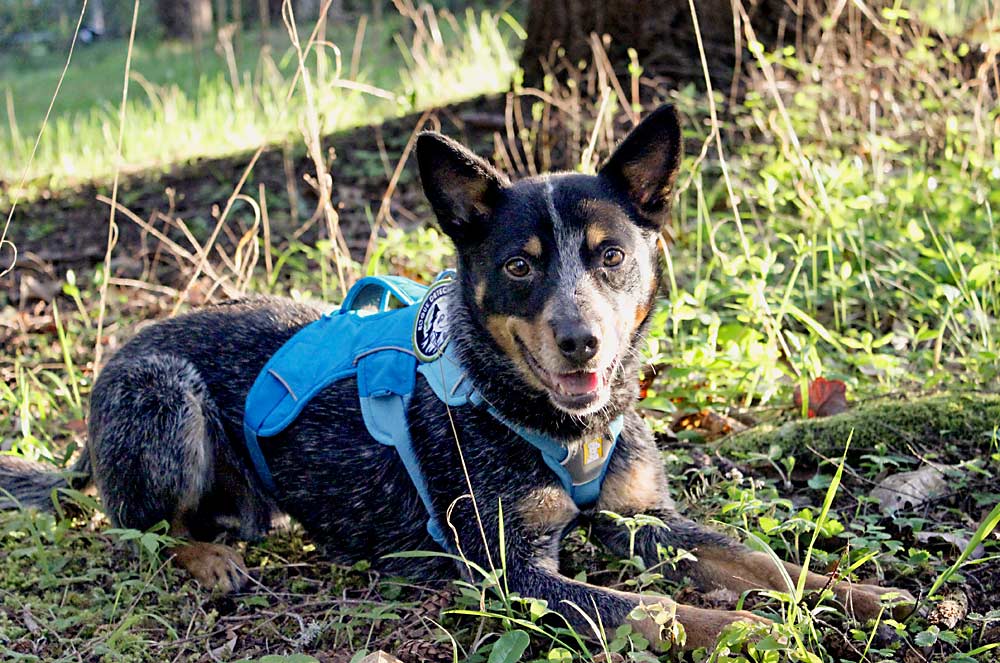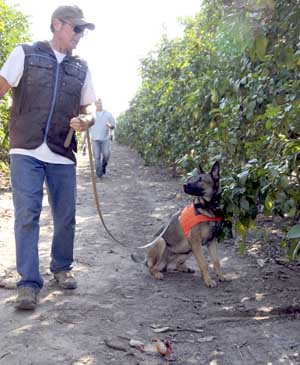
Dogs have long been known for their dazzling sense of smell, and the right dogs can be trained to sniff out everything from drugs and explosives to bugs and native plants. In the tree fruit industry, dogs have been trained and tested to detect plum pox virus and citrus canker in East Coast fruit trees.
Could man’s best friend aid in the fight against little cherry disease as well?
It’s a question the Washington Tree Fruit Research Commission is throwing a little support behind, in a small pilot project aimed at determining two things: Does the disease itself emit any olfactory cues, and, if so, can dogs detect them?
Philip Berger, executive director of the U.S. Department of Agriculture’s Center for Plant Health Science and Technology, sees potential for a lot of agricultural systems, including possibly little cherry disease. Grapevine red blotch marks another.
“In the most common situation with woody plants, where the pathogen can be latent or undetectable for a long time, the evidence I’ve seen indicates that the canines can pick up something much earlier than we can,” he said.
To be trained for detection, dogs are offered odors from the specific item that is to be detected and rewarded either with food or play when they sniff it out.
For decades, USDA’s Plant Protection and Quarantine program has been training canines to detect fruits, vegetables and certain meat products that are restricted or prohibited agricultural imports. The center opened its National Detector Dog Training Center in 1984 with just one dog and one trainer.
Today, the center, located in Newnan, Georgia, sits on 17 acres with eight buildings and 100 kennels, and those dogs have since been trained and deployed to detect multiple agricultural and forestry diseases and pests across the country.
According to the center, dogs found citrus canker disease more than 99 percent of the time during training exercises in Florida, and dog teams are also training to detect citrus greening disease.
In Hawaii, the dogs searched for the invasive coconut rhinoceros beetle (CRB) in mulch piles, a choice breeding site for the palm-killing insect. Their detection rate: nearly 90 percent for CRB larvae living 2- to 10-inches deep in mulch. They could also confirm that mulch piles were CRB-free in half the time it takes a four-person survey crew.
Tim Gottwald, research leader and plant pathologist at USDA’s Horticultural Research Laboratory in Fort Pierce, Florida, first began working with dogs to detect citrus canker in the mid-1990s, as the disease was souring international trade, prompting huge eradication programs and quarantines. He has since been involved in canine detection efforts for citrus greening and plum pox.

Ten dogs had an accuracy rate of 99.1 percent at identifying trees inoculated with citrus greening in a 10,000-tree test. “There’s no assay in the world, molecular or otherwise, that comes with that level of accuracy,” he said.
He’s seen similar results for citrus canker and continues to research the dogs’ ability on plum pox — and expects equivalent results.
The research can be difficult if the pathogen is a quarantine virus. In the case of plum pox, working with the dogs in the field required taking them to Canada.
Already, though, the dogs have shown they can detect several different strains of plum pox virus, and they can pick it up equally as well in dormant trees, with no foliage, as they can leafy trees in season, Gottwald said.
Dogs also help to address the issue of perennial sampling, Berger said.
“In many cases, the pathogen is unevenly distributed in the tree, certainly in the early stages of infection. With our current issues of indexing, having to take leaf samples, process in a lab, in a larger tree the success of picking the correct sample site is limited,” he said. “A dog sniffs the entire tree — doesn’t tell where it is in the tree, but alerts that it is likely there.”
The costs of establishing a canine detection program for long-term eradication can be high, depending on the goals.
For example, Berger estimates that establishing a program where two dogs and one handler are used primarily in foundation plantings as part of a clean stock program might cost $150,000 to $200,000 a year for the first couple of years, though such a program could probably be up and running in two years.
“On the other hand, I doubt they have an opportunity to take little cherry out of their system, to eradicate it, so it’s a bargain. The dogs can actually do that,” he said. “Again, that depends on the goals of the program.”
Rob Curtiss, special projects coordinator for the Washington Tree Fruit Research Commission, won’t call the costs “cheap,” but said he believes it can be done for less money than the large federal program, which includes staff, facilities and dozens of dogs.
A commodity group that wanted a dog program would simply have to pay the salary of and provide a vehicle for the handler and house a dog for a year, after the set-up and training — likely around $100,000 annually, he said.
Compared to current test methods, which Curtiss estimated at $25 per sample, the dogs show great potential.
However, Curtiss acknowledged that he struggled to maintain funding for similar research he did on the rhinoceros beetle pilot project in Hawaii, despite the dogs’ strong results.
“It’s not even that it’s really that expensive. It’s just that there’s a perception that the dogs are just pets and they’re not a tool, and in order to change that perception, I think a lot of outreach needs to happen to the people who are making these funding decisions,” he said. “There’s definitely a stigma that needs to be overcome.”
Berger specifically sees potential to apply canine detection for little cherry disease at the nursery level. “That’s where they could be most effective,” he said. “They could aid to clean up foundation stock, and, not to mention, they could obviously be used in certification systems and even in whole commercial orchards.”
But, he said, growers have to deal with this caveat: “Are they willing to take action on the results of the canine, when they’re unable to confirm the results with another method?” he asked. “If the validation tells you they’re 95 percent accurate, and recognizing they will likely be alerting on trees that are asymptomatic, are you willing to trust the dogs?”
Pilot project details

The Washington Tree Fruit Research Commission has approved a $6,462 pilot project to determine if dogs can discern little cherry disease-infected plants from clean plants.
The pilot project will initially run five days, with the option to extend up to an additional 10 days if needed. The preliminary work involves offering odors from infected and clean plant materials to the dogs to evaluate their responses. Positive responses and the display of the desired behavior will be rewarded as part of the dog’s operant conditioning program.
The Clean Plant Center Northwest is providing disease-free plant materials (leaves, branches, seedlings, etc.), as well as materials inoculated with little cherry virus 2 and Western X.
The project is aiming for 80 percent proficiency by the dogs. If they are found to reliably detect infected cherry parts or plants, then the pilot will be considered a success and funding will be sought for a full-scale program.
The Tree Fruit Research Commission is working with Rogue Detection Teams of Cusick, Washington, which will provide one research scientist and detection dog team for the program. •
—by Shannon Dininny






Leave A Comment